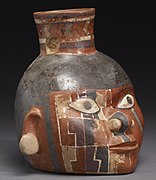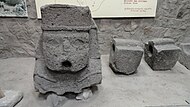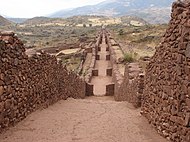
Tiwanaku is a Pre-Columbian archaeological site in western Bolivia, near Lake Titicaca, about 70 kilometers from La Paz, and it is one of the largest sites in South America. Surface remains currently cover around 4 square kilometers and include decorated ceramics, monumental structures, and megalithic blocks. In AD 800 the site has been conservatively estimated to have been inhabited by 10,000 to 20,000 people.
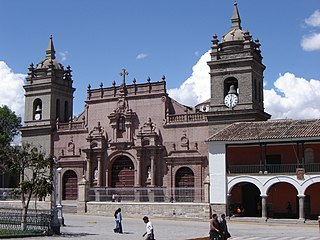
Ayacucho is the capital city of Ayacucho Region and of Huamanga Province, Ayacucho Region, Peru.

In "Southern Andean Iconographic Series" the Staff God pose is a religious icon and a standardized pose reminiscent in its way of the standardized poses in Byzantine art. The pose shows a front-facing human or human-like figure with vertical attributes, one in each hand. There is no uniform representation of a "Staff God". Dozens of variations of "Staff Gods" exist. Some scholars think that some of these personages are possible depictions of Viracocha or Thunupa. However, there is little evidence to support the idea that these front-facing figures do represent deities. Some researchers point to their attributes and spatial organization which seem to indicate that they are ritual practitioners. Some attributes in their hands were identified as Qirus, Snuff trays and Spear-throwers. The "rays" radiating or sprouting out of the faces of Tiwanaku front-facing figures appear to have approximately the value of an aureole. They may represent flows and distribution of energy. At the Wari site of Conchopata a vessel was found which shows a Staff God in which the "rays" can be interpreted as a Anadenanthera colubrina tree sprouting from its head whereas the circular elements do represent its seed pods.

The Chachapoyas, also called the "Warriors of the Clouds", was a culture of the Andes living in the cloud forests of the southern part of the Department of Amazonas of present-day Peru. The Inca Empire conquered their civilization shortly before the Spanish conquest in the 16th century. At the time of the arrival of the conquistadors, the Chachapoyas were one of the many nations ruled by the Incas, although their incorporation had been difficult due to their constant resistance to Inca troops.
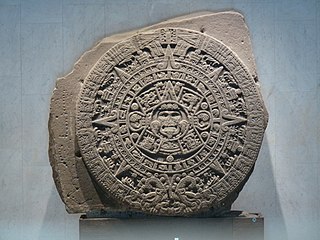
Pre-Columbian art refers to the visual arts of indigenous peoples of the Caribbean, North, Central, and South Americas from at least 13,000 BCE to the European conquests starting in the late 15th and early 16th centuries. The Pre-Columbian era continued for a time after these in many places, or had a transitional phase afterwards. Many types of perishable artifacts that were once very common, such as woven textiles, typically have not been preserved, but Precolumbian monumental sculpture, metalwork in gold, pottery, and painting on ceramics, walls, and rocks have survived more frequently.

The Paracas culture was an Andean society existing between approximately 800 BCE and 100 BCE, with an extensive knowledge of irrigation and water management and that made significant contributions in the textile arts. It was located in what today is the Ica Region of Peru. Most information about the lives of the Paracas people comes from excavations at the large seaside Paracas site on the Paracas Peninsula, first formally investigated in the 1920s by Peruvian archaeologist Julio Tello.

The Chakana is a stepped cross motif used by the Inca and pre-incan Andean societies. The most commonly used variation of this symbol today is made up of an equal-armed cross indicating the cardinal points of the compass and a superimposed square. Chakana means 'bridge', and means 'to cross over' in Quechua. The Andean cross motif appears in pre-contact artifacts such as textiles and ceramics from such cultures as the Chavín, Wari, Chancay, and Tiwanaku, but with no particular emphasis and no key or guide to a means of interpretation. The anthropologist Alan Kolata calls the Andean cross "one of the most ubiquitous, if least understood elements in Tiwanaku iconography". The Andean cross symbol has a long cultural tradition spanning 4,000 years up to the Inca Empire.
The present-day Department of Amazonas in Peru, occupying part of the western Amazon basin, carries evidence of human cultures predating the Inca Empire. The presence of the Chachapoya culture and the Wari culture in architectural excavations allow for evidence of multiple civilized presences previous to the conquest of the area by the Incan Empire.

The Gate of the Sun, also known as the Gateway of the Sun, is a monolith carved in the form of an arch or gateway at the site of Tiahuanaco by the Tiwanaku culture, an Andean civilization of Bolivia that thrived around Lake Titicaca in the Andes of western South America around 500-950 AD.

The Wari Empire or Huari Empire was a political formation that emerged around 600 AD (CE) in Peru's Ayacucho Basin and grew to cover much of coastal and highland Peru. The empire lasted for about 500 years, until 1100 CE. It existed during the same era as the Tiwanaku culture, and at one time, was thought to have been derived from it. In 2008, archeologists found a precolumbian city, the Northern Wari ruins near modern Chiclayo. The find was the first extensive settlement related to the Wari culture discovered that far north.

The Andean textile tradition once spanned from the Pre-Columbian to the Colonial era throughout the western coast of South America, but was mainly concentrated in Peru. The arid desert conditions along the coast of Peru have allowed for the preservation of these dyed textiles, which can date to 6000 years old. Many of the surviving textile samples were from funerary bundles, however, these textiles also encompassed a variety of functions. These functions included the use of woven textiles for ceremonial clothing or cloth armor as well as knotted fibers for record-keeping. The textile arts were instrumental in political negotiations, and were used as diplomatic tools that were exchanged between groups. Textiles were also used to communicate wealth, social status, and regional affiliation with others. The cultural emphasis on the textile arts was often based on the believed spiritual and metaphysical qualities of the origins of materials used, as well as cosmological and symbolic messages within the visual appearance of the textiles. Traditionally, the thread used for textiles was spun from indigenous cotton plants, as well as alpaca and llama wool.

The Lima culture was an indigenous civilization which existed in modern-day Lima, Peru during the Early Intermediate Period, extending from roughly 100 to 650. This pre-Incan culture, which overlaps with surrounding Paracas, Moche, and Nasca civilizations, was located in the desert coastal strip of Peru in the Chillon, Rimac and Lurin River valleys. It can be difficult to differentiate the Lima culture from surrounding cultures due to both its physical proximity to other, and better documented cultures, in Coastal Peru, and because it is chronologically very close, if not over lapped, by these other cultures as well. These factors all help contribute to the obscurity of the Lima culture, of which much information is still left to be learned.

The Andean civilizations were South American complex societies of many indigenous people. They stretched down the spine of the Andes for 4,000 km (2,500 mi) from southern Colombia, to Ecuador and Peru, including the deserts of coastal Peru, to north Chile and northwest Argentina. Archaeologists believe that Andean civilizations first developed on the narrow coastal plain of the Pacific Ocean. The Caral or Norte Chico civilization of coastal Peru is the oldest known civilization in the Americas, dating back to 3500 BCE. Andean civilization is one of the six "pristine" civilizations of the world, created independently and without influence by other civilizations.

The history of human habitation in the Andean region of South America stretches from circa 15,000 BCE to the present day. Stretching for 7,000 km (4,300 mi) long, the region encompasses mountainous, tropical and desert environments. This colonisation and habitation of the region has been affected by its unique geography and climate, leading to the development of unique cultural and socn.
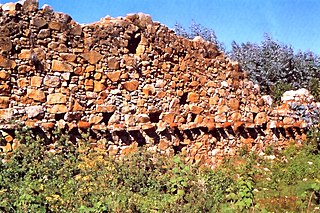
Viracochapampa, Huiracochapampa, or Wiracochapampa is an archaeological site with the remains of a building complex of ancient Peru of pre-Inca times. It was one of the administrative centers of the Wari culture. Viracochapampa is located about 3.5 km north of Huamachuco in the region of La Libertad at an elevation of 3,070 metres (10,072 ft).

Osmore River system flows northeast to southwest in the Moquegua Region of southern coastal Peru. The river has its origin in the snow peaks of the Chuqi Ananta and Arundane mountains, at an elevation of 5,100 metres (16,700 ft) above sea level. It changes names as it descends from the Andes: From its origin it is called the Moquegua, then Osmore in the middle valley as Rio Coscori and Rio Tumilaca including where the river disappears into subterranean channels, and further down in the lower reaches as Rio Ilo.

The Tiwanaku Polity was a Pre-Columbian polity in western Bolivia based in the southern Lake Titicaca Basin. Tiwanaku was one of the most significant Andean civilizations. Its influence extended into present-day Peru and Chile and lasted from around 600 to 1000 AD. Its capital was the monumental city of Tiwanaku, located at the center of the polity's core area in the southern Lake Titicaca Basin. This area has clear evidence for large-scale agricultural production on raised fields that probably supported the urban population of the capital. Researchers debate whether these fields were administered by a bureaucratic state (top-down) or through a federation of communities with local autonomy. Tiwanaku was once thought to be an expansive military empire, based mostly on comparisons to the later Inca Empire. However, recent research suggests that labelling Tiwanaku as an empire or even different varieties of a state may even be misleading. Tiwanaku is missing a number of features used to define these types of polities: there is no defensive architecture at any Tiwanaku site or changes in weapon technology, there are no princely burials or other evidence of a ruling dynasty or a formal social hierarchy, no evidence of state-maintained roads or outposts, and no markets.
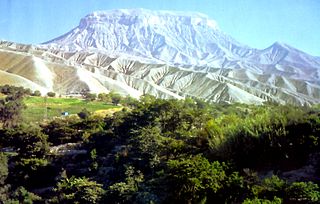
Cerro Baúl is an ancient political outpost and ceremonial center settlement in Peru established by the pre-Incan empire called the Wari. Cerro Baúl is a terraced mountain, 2000 feet above its surroundings, with a settlement on the cliff tops themselves and in the immediate surroundings. Among other finds are the remnants of a brewery and large buildings that may have been used for ceremonial feasting. There is evidence of damage that has been interpreted as a careful and deliberate destruction, by the city's own people, of several buildings prior to the mesa's being vacated.

Pre-Columbian Bolivia covers the historical period between 10,000 BCE, when the Upper Andes region was first populated and 1532, when Spanish conquistadors invaded Inca empire. The Andes region of Pre-Columbian South America was dominated by the Tiwanaku civilization until about 1200, when the regional kingdoms of the Aymara emerged as the most powerful of the ethnic groups living in the densely populated region surrounding Lake Titicaca. Power struggles continued until 1450, when the Incas incorporated upper Bolivia into their growing empire. Based in present-day Peru, the Incas instituted agricultural and mining practices that rivaled those put in place many years later by European conquerors. They also established a strong military force, and centralized political power. Despite their best efforts however, the Incas never completely controlled the nomadic tribes of the Bolivian lowlands, nor did they fully assimilate the Aymara kingdoms into their society. These internal divisions doomed the Inca Empire when European conquerors arrived.
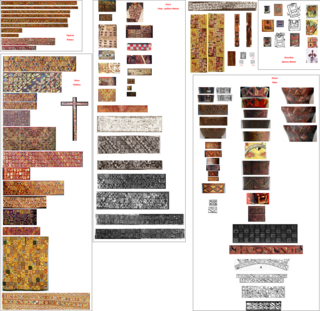
Tocapu was a decorative artwork with discrete geometrical motifs. It was associated with Andean textiles, especially for the use of the Royals' clothing. Tocapu was also painted on wooden boards.





